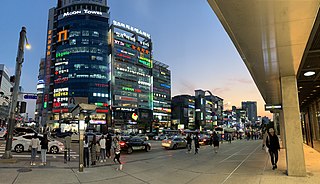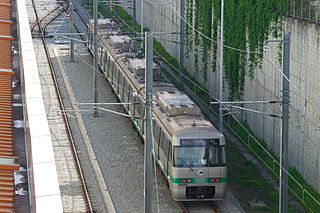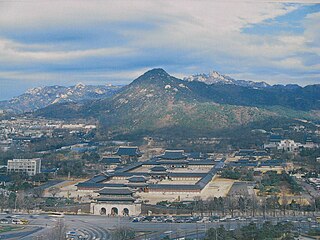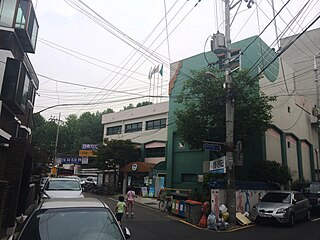
Daejeon is South Korea's fifth-largest metropolis, with a population of 1.5 million as of 2019. Located in a central lowland valley between the Sobaek Mountains and the Geum River, the city is known both as a technology and research center, and for its close relationship with the natural environment. Daejeon serves as a hub of transportation for major rail and road routes, and is approximately 50 minutes from the capital, Seoul, by KTX or SRT high speed rail.

Cheongju is the capital and largest city of North Chungcheong Province in South Korea.

South Korea is made up of 22 first-tier administrative divisions: 6 metropolitan cities, 1 special city, 1 special self-governing city, and 14 provinces, including three special self-governing provinces and five claimed by the ROK government. These are further subdivided into a variety of smaller entities, including cities, counties, districts, towns, townships, neighborhoods and villages.

Cheonan is the largest and most densely populated city of Chungcheongnam-do, South Korea, and the third largest city in the Hoseo region after Daejeon and Cheongju. Cheonan borders Gyeonggi-do in the north, Chungcheongbuk-do to the east and southeast, Sejong City to the south and Asan-si and Gongju-si to the west and southwest.

Daejeon Subway Line 1 is a subway line is located in Daejeon, South Korea. After excluding the Seoul metropolitan area, it was the fourth subway line created in South Korea, following Busan, Daegu, and Gwangju. Its line color is ● green. It is 22.6 km (14.0 mi) long with 22 stations. It is the first of five planned lines for the Daejeon Metro.
Hansol Group (Korean: 한솔그룹) is a South Korean conglomerate, or chaebol. The corporation's main operations are paper products, electronics, chemicals, logistics, IT technology and solution services, household interiors, and construction. Hansol used to be a part of Samsung Group, and is still owned by one of the relatives of the Samsung and Shinsegae family.

Jung District is one of the 25 districts of Seoul, South Korea.

Jongno District is a district in Downtown Seoul, South Korea. It is the historic center of Seoul, and contains the Joseon-era royal palace Gyeongbokgung and the former presidential residence, the Blue House.

Dongdaemun District is one of the 25 districts of Seoul, South Korea.

Gwangjin District is one of the 25 districts of Seoul, South Korea. It is located on the north bank of the Han River on the eastern end of Seoul. The district was split from the neighboring Seongdong District in 1995.

Sejong or Sejong City, officially the Sejong Special Self-Governing City, is a special self-governing city and the de facto administrative capital of South Korea.
Tongin-dong is a dong, neighbourhood of Jongno-gu in Seoul, South Korea. It is a legal dong administered under its administrative dong, Hyoja-dong.

Hapjeong-dong is a dong (neighborhood) of Mapo District, Seoul, South Korea.
Addresses in South Korea are used to identify specific locations within the country. South Korea has replaced its land lot-based address system with one based on street names. The switching of the address system is to make it easier for foreigners as well as Koreans to find their destinations. The current official system, the Road Name Address system rolled out on July 29, 2011, uses street names and building numbers, and is similar to the systems used by the United States, Canada, Australia and Europe. The previous system was the land-lot based address, which is also used in Japan, but not within the Mandarin-speaking world. The old land-lot addressing system has been officially decommissioned since December 31, 2013.

Sejong University is a private university located in Seoul, South Korea known for its standing in hospitality and tourism management, dancing, animation and rhythmic gymnastics. Founded as the Kyung Sung Humanities Institute, it was renamed in 1978 to its present name in honor of Sejong the Great, the fourth king of the Joseon Dynasty and overseer of the creation of the Korean alphabet Hangul.
The Aviation and Railway Accident Investigation Board is an agency of the South Korean government that investigates aviation and railway accidents, subservient to the Ministry of Land, Infrastructure and Transport (MOLIT) and headquartered in Sejong City.
National Route 36 is a national highway in South Korea connects Boryeong to Sejong City, Cheongju, Chungju, and Uljin. It established on 31 August 1971.

Sejong A is a constituency of the National Assembly of South Korea. The constituency consists of the southern portion of Sejong City. As of 2024, 171,472 eligible voters were registered in the constituency.













